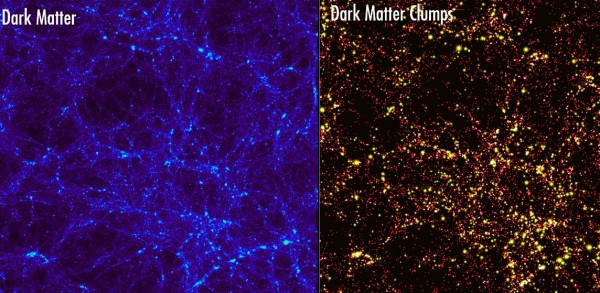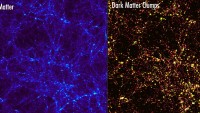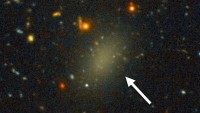NASA Scientists Try New Methods in Search for Dark Matter
| Arthur Dominic Villasanta | | Dec 31, 2016 08:43 AM EST |
(Photo : Virgo consortium / A. Amblard / ESA) Left: simulations of the distribution of dark matter in the Universe around 3 billion years after the Big Bang. Right: clumps of dark matter (red), with those larger than 300 million times the mass of the Sun highlighted in yellow.
Scientists dead set on unraveling the secrets of dark matter are crunching six years worth of data from NASA's Fermi Gamma-ray Space Telescope to develop novel approaches as they search for cosmic signals that could reveal what dark matter is made of.
They've turned their attention to hypothetical axion particles; studied the gamma-ray emissions from a large satellite galaxy of our Milky Way and analyzed the faint glow of gamma rays covering the entire sky.
Like Us on Facebook
None of these studies, however, identified signals clearly attributable to dark matter, which is invisible and undetectable. Despite this, the hard work and the results help scientists determine what dark matter cannot be by ruling out numerous theoretical dark matter models.
The nature of dark matter remains one of today's biggest mysteries. Dark matter constitutes 85 percent of all matter in the universe. This massive presence affects how galaxies rotate and how light passes through massive galaxy clusters.
But what dark matter is, and its constituents remain unknown.
The first study investigated the possibility dark matter consists of hypothetical particles called axions or other particles with similar properties.
A team led by Manuel Meyer at Stockholm University searched for these effects in the gamma rays from the central galaxy of the Perseus galaxy cluster, whose high-energy emissions are thought to be associated with a supermassive black hole at its center.
Meyer's team collected observations from Fermi's Large Area Telescope (LAT) but didn't find any axion-related distortions in the gamma-ray signal.
"While we don't yet know what dark matter is, our results show we can probe axion-like models and provide the strongest constraints to date for certain masses," said Meyer.
Other dark matter candidates are weakly interacting massive particles or WIMPs. In some theoretical models, colliding WIMPs either annihilate each other or decay in space.
In the second study, scientists sought these signals from the Small Magellanic Cloud (SMC), the second-largest of the satellite galaxies orbiting our Milky Way. The SMC's conventional sources of gamma rays, such as pulsars and processes related to the formation of massive stars, are well established, and its dark matter content is known from the galaxy's well-measured rotation.
"These properties make the SMC a great object for searches for any unexplained gamma-ray excess, which could potentially be a WIMP signature," said KIPAC researcher Eric Charles, co-author of a paper published on March 22 in Physical Review D.
The researchers modeled the dark matter content of the satellite galaxy, showing it possesses enough dark matter to theoretically produce detectable signals for two WIMP types.
However, "no signal from dark matter annihilation was found to be statistically significant," said lead author Regina Caputo from the University of California, Santa Cruz.
In the third study, a research team led by Clemson University's Marco Ajello and KIPAC's Mattia Di Mauro analyzed the background glow of gamma rays seen all over the sky.
The nature of this light, called the extragalactic gamma-ray background (EGB), has been debated since it was first measured by NASA's Small Astronomy Satellite 2 in the early 1970s. Fermi has shown that much of this light arises from gamma-ray sources that cannot be identified as individual sources, particularly galaxies called blazars powered by material falling toward gigantic black holes.
"We performed a statistical analysis of the EGB, in which we looked at very dim objects and asked whether we can account for all detected gamma-ray photons with known astrophysical sources," said Di Mauro.
"There is very little room left for signals from exotic sources in the EGB, which in turn means that any contribution from these sources must be quite small. This information may help us place limits on how often WIMP particles collide or decay."
Tagsdark matter, Fermi Gamma-ray Space Telescope, NASA, axions, weakly interacting massive particles, WIMPs
©2015 Chinatopix All rights reserved. Do not reproduce without permission
EDITOR'S PICKS
-

Did the Trump administration just announce plans for a trade war with ‘hostile’ China and Russia?
-

US Senate passes Taiwan travel bill slammed by China
-

As Yan Sihong’s family grieves, here are other Chinese students who went missing abroad. Some have never been found
-

Beijing blasts Western critics who ‘smear China’ with the term sharp power
-

China Envoy Seeks to Defuse Tensions With U.S. as a Trade War Brews
-

Singapore's Deputy PM Provides Bitcoin Vote of Confidence Amid China's Blanket Bans
-

China warns investors over risks in overseas virtual currency trading
-

Chinese government most trustworthy: survey
-

Kashima Antlers On Course For Back-To-Back Titles
MOST POPULAR
LATEST NEWS
Zhou Yongkang: China's Former Security Chief Sentenced to Life in Prison

China's former Chief of the Ministry of Public Security, Zhou Yongkang, has been given a life sentence after he was found guilty of abusing his office, bribery and deliberately ... Full Article
TRENDING STORY

China Pork Prices Expected to Stabilize As The Supplies Recover

Elephone P9000 Smartphone is now on Sale on Amazon India

There's a Big Chance Cliffhangers Won't Still Be Resolved When Grey's Anatomy Season 13 Returns

Supreme Court Ruled on Samsung vs Apple Dispute for Patent Infringement

Microsoft Surface Pro 5 Rumors and Release Date: What is the Latest?














